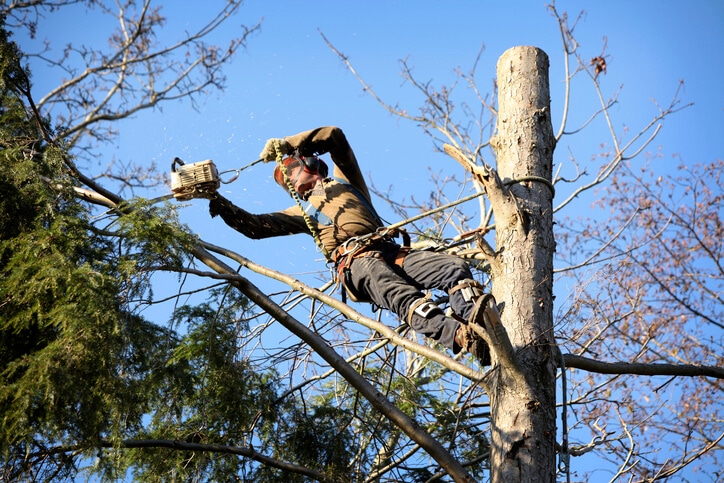Trees are more than just beautiful additions to our surroundings—they are vital to the health of our environment and the well-being of our communities. They provide shade, improve air quality, enhance property values, and contribute to the biodiversity of any area. However, trees require regular care and maintenance to stay healthy, safe, and aesthetically pleasing.
Neglecting proper tree care can lead to a host of problems, from disease and decay to safety hazards such as falling branches. Whether you have a single tree in your yard or manage a larger green space, understanding the principles of tree maintenance is crucial. This article explores the benefits of proactive tree care, the signs of trouble, essential maintenance practices, and when it’s time to call in a professional Tree Service.
Why Tree Care Matters
Healthy trees contribute significantly to the well-being of the ecosystem. They act as natural air purifiers, absorbing carbon dioxide and releasing oxygen. Their root systems stabilize soil, reduce erosion, and promote water retention. Additionally, trees offer shelter and food for a wide range of wildlife species.
From a practical standpoint, trees can also reduce energy costs by providing shade in summer and windbreaks in winter. Properties with mature, well-maintained trees often enjoy higher market values. Conversely, neglected or diseased trees can become liabilities, posing risks to property and safety.
Common Tree Issues Homeowners Face
Despite their resilience, trees are vulnerable to various threats. Understanding these potential issues is the first step in effective care.
1. Pests and Diseases
Insects like aphids, beetles, and borers can severely damage tree bark and foliage. Fungal infections such as powdery mildew, root rot, and canker diseases can weaken or kill trees if not treated promptly.
2. Improper Pruning
Poor pruning techniques, such as topping or removing too many branches at once, can stress the tree and lead to long-term damage. Improper cuts can also expose the tree to infections.
3. Compacted Soil
Heavy foot traffic or construction around trees can compact the soil, limiting the roots’ ability to absorb water and nutrients.
4. Storm Damage
High winds, lightning, and ice storms can snap limbs, split trunks, or even uproot trees. Immediate attention is often needed after such events to mitigate safety hazards.
5. Girdling Roots
These roots grow around the trunk and cut off nutrient flow. They are often the result of poor planting techniques or restricted growing space.
Basic Tree Maintenance Tips
To ensure your trees stay healthy and strong, follow these core maintenance practices.
1. Regular Inspection
Visually inspect your trees every season. Look for dead or broken branches, leaf discoloration, peeling bark, or signs of pests. Early detection is key to successful treatment.
2. Watering Appropriately
Trees need more water during dry spells, especially young or newly planted ones. However, overwatering can be just as harmful as drought. Use mulch to retain moisture and regulate soil temperature.
3. Mulching
Apply a layer of organic mulch around the base of the tree to conserve moisture, reduce weeds, and improve soil quality. Avoid piling mulch directly against the trunk, which can cause rot.
4. Pruning Carefully
Prune trees during their dormant season to encourage new growth and remove dead or diseased limbs. Use clean, sharp tools and avoid removing more than 25% of the tree’s canopy at once.
5. Fertilizing When Needed
Most mature trees do not require regular fertilization if planted in healthy soil. However, young or stressed trees may benefit from periodic nutrient boosts.
Recognizing When a Tree Needs Help
Trees often give subtle signs that something is wrong. Recognizing these early warnings can prevent bigger issues:
- Wilting or curling leaves out of season
- Mushrooms growing at the base of the trunk
- Unusual insect activity
- Cracks in the trunk
- Leaning or instability in the soil around the base
If you notice any of these symptoms, it may be time to consult a certified arborist or a trusted Tree Service provider for a full health evaluation.
Professional Tree Services: What to Expect
While basic maintenance can be handled by property owners, certain tasks require specialized skills and equipment. Tree removal, major pruning, pest treatments, and storm damage repair are best handled by professionals.
A reputable Tree Service typically offers a range of services, including:
- Tree Trimming and Pruning: Ensures the tree maintains a safe structure and promotes healthy growth.
- Tree Removal: For dead, diseased, or dangerous trees that pose a risk to people or property.
- Stump Grinding: Removes unsightly stumps to allow for new planting or landscaping.
- Tree Health Assessments: Diagnoses diseases and pests and recommends treatment plans.
- Emergency Services: Responds to tree-related hazards following storms or other urgent situations.
Hiring certified professionals ensures that work is done safely, efficiently, and in compliance with local regulations.
The Value of Preventative Tree Care
One of the biggest misconceptions about tree care is that it’s only necessary when something goes wrong. In reality, preventative maintenance is the most effective and affordable approach. When trees are regularly inspected, pruned, and nourished, they are less likely to suffer from disease, pest infestation, or structural failure.
Moreover, proactive care can significantly extend the lifespan of your trees. Rather than removing and replacing mature trees—an expensive and environmentally costly process—you can preserve the ones you have through early intervention and consistent upkeep.
Choosing the Right Tree for Your Space
Tree selection is a vital part of long-term success. The wrong species in the wrong location can lead to future headaches. Here are some tips when planting new trees:
- Consider Size at Maturity: Choose a species that will fit comfortably in your space once fully grown.
- Understand Root Spread: Roots can damage sidewalks, driveways, or foundations if planted too close.
- Assess Sunlight and Soil Conditions: Match the tree’s needs to your site’s natural conditions.
- Avoid Invasive Species: Some trees grow aggressively and can outcompete native plants.
Consulting a landscape professional or arborist before planting ensures you choose a tree that complements your property and thrives in your environment.
Sustainable Tree Practices
Environmental stewardship is more important than ever. Sustainable tree care ensures your practices are not only beneficial for your property but also for the wider ecosystem.
- Plant Native Trees: Native species are better adapted to local conditions and support local wildlife.
- Limit Chemical Use: Pesticides and herbicides can harm beneficial insects and pollinators.
- Compost and Recycle: Use tree trimmings as mulch or compost when possible.
- Support Biodiversity: Plant a variety of tree species to create a healthier, more resilient landscape.
By taking a sustainable approach, you contribute to healthier urban forests and a more balanced ecosystem.
Conclusion: Trees Are Worth the Investment
Trees enrich our lives in countless ways. From their environmental benefits to their contribution to property beauty and value, trees are a long-term investment that pays dividends for generations. However, like any living organism, trees require care, attention, and sometimes expert intervention to thrive.
If you’re uncertain about the health of your trees or feel overwhelmed by the demands of tree maintenance, it may be time to consult a professional Tree Service. With their expertise and experience, you can protect your landscape, enhance your outdoor space, and ensure that your trees remain safe and vibrant for years to come.
The Essential Guide to Tree Care and Maintenance
Trees are more than just beautiful additions to our surroundings—they are vital to the health of our environment and the well-being of our communities. They provide shade, improve air quality, enhance property values, and contribute to the biodiversity of any area. However, trees require regular care and maintenance to stay healthy, safe, and aesthetically pleasing.
Neglecting proper tree care can lead to a host of problems, from disease and decay to safety hazards such as falling branches. Whether you have a single tree in your yard or manage a larger green space, understanding the principles of tree maintenance is crucial. This article explores the benefits of proactive tree care, the signs of trouble, essential maintenance practices, and when it’s time to call in a professional Tree Service.
Why Tree Care Matters
Healthy trees contribute significantly to the well-being of the ecosystem. They act as natural air purifiers, absorbing carbon dioxide and releasing oxygen. Their root systems stabilize soil, reduce erosion, and promote water retention. Additionally, trees offer shelter and food for a wide range of wildlife species.
From a practical standpoint, trees can also reduce energy costs by providing shade in summer and windbreaks in winter. Properties with mature, well-maintained trees often enjoy higher market values. Conversely, neglected or diseased trees can become liabilities, posing risks to property and safety.
Common Tree Issues Homeowners Face
Despite their resilience, trees are vulnerable to various threats. Understanding these potential issues is the first step in effective care.
1. Pests and Diseases
Insects like aphids, beetles, and borers can severely damage tree bark and foliage. Fungal infections such as powdery mildew, root rot, and canker diseases can weaken or kill trees if not treated promptly.
2. Improper Pruning
Poor pruning techniques, such as topping or removing too many branches at once, can stress the tree and lead to long-term damage. Improper cuts can also expose the tree to infections.
3. Compacted Soil
Heavy foot traffic or construction around trees can compact the soil, limiting the roots’ ability to absorb water and nutrients.
4. Storm Damage
High winds, lightning, and ice storms can snap limbs, split trunks, or even uproot trees. Immediate attention is often needed after such events to mitigate safety hazards.
5. Girdling Roots
These roots grow around the trunk and cut off nutrient flow. They are often the result of poor planting techniques or restricted growing space.
Basic Tree Maintenance Tips
To ensure your trees stay healthy and strong, follow these core maintenance practices.
1. Regular Inspection
Visually inspect your trees every season. Look for dead or broken branches, leaf discoloration, peeling bark, or signs of pests. Early detection is key to successful treatment.
2. Watering Appropriately
Trees need more water during dry spells, especially young or newly planted ones. However, overwatering can be just as harmful as drought. Use mulch to retain moisture and regulate soil temperature.
3. Mulching
Apply a layer of organic mulch around the base of the tree to conserve moisture, reduce weeds, and improve soil quality. Avoid piling mulch directly against the trunk, which can cause rot.
4. Pruning Carefully
Prune trees during their dormant season to encourage new growth and remove dead or diseased limbs. Use clean, sharp tools and avoid removing more than 25% of the tree’s canopy at once.
5. Fertilizing When Needed
Most mature trees do not require regular fertilization if planted in healthy soil. However, young or stressed trees may benefit from periodic nutrient boosts.
Recognizing When a Tree Needs Help
Trees often give subtle signs that something is wrong. Recognizing these early warnings can prevent bigger issues:
- Wilting or curling leaves out of season
- Mushrooms growing at the base of the trunk
- Unusual insect activity
- Cracks in the trunk
- Leaning or instability in the soil around the base
If you notice any of these symptoms, it may be time to consult a certified arborist or a trusted Tree Service provider for a full health evaluation.
Professional Tree Services: What to Expect
While basic maintenance can be handled by property owners, certain tasks require specialized skills and equipment. Tree removal, major pruning, pest treatments, and storm damage repair are best handled by professionals.
A reputable Tree Service typically offers a range of services, including:
- Tree Trimming and Pruning: Ensures the tree maintains a safe structure and promotes healthy growth.
- Tree Removal: For dead, diseased, or dangerous trees that pose a risk to people or property.
- Stump Grinding: Removes unsightly stumps to allow for new planting or landscaping.
- Tree Health Assessments: Diagnoses diseases and pests and recommends treatment plans.
- Emergency Services: Responds to tree-related hazards following storms or other urgent situations.
Hiring certified professionals ensures that work is done safely, efficiently, and in compliance with local regulations.
The Value of Preventative Tree Care
One of the biggest misconceptions about tree care is that it’s only necessary when something goes wrong. In reality, preventative maintenance is the most effective and affordable approach. When trees are regularly inspected, pruned, and nourished, they are less likely to suffer from disease, pest infestation, or structural failure.
Moreover, proactive care can significantly extend the lifespan of your trees. Rather than removing and replacing mature trees—an expensive and environmentally costly process—you can preserve the ones you have through early intervention and consistent upkeep.
Choosing the Right Tree for Your Space
Tree selection is a vital part of long-term success. The wrong species in the wrong location can lead to future headaches. Here are some tips when planting new trees:
- Consider Size at Maturity: Choose a species that will fit comfortably in your space once fully grown.
- Understand Root Spread: Roots can damage sidewalks, driveways, or foundations if planted too close.
- Assess Sunlight and Soil Conditions: Match the tree’s needs to your site’s natural conditions.
- Avoid Invasive Species: Some trees grow aggressively and can outcompete native plants.
Consulting a landscape professional or arborist before planting ensures you choose a tree that complements your property and thrives in your environment.
Sustainable Tree Practices
Environmental stewardship is more important than ever. Sustainable tree care ensures your practices are not only beneficial for your property but also for the wider ecosystem.
- Plant Native Trees: Native species are better adapted to local conditions and support local wildlife.
- Limit Chemical Use: Pesticides and herbicides can harm beneficial insects and pollinators.
- Compost and Recycle: Use tree trimmings as mulch or compost when possible.
- Support Biodiversity: Plant a variety of tree species to create a healthier, more resilient landscape.
By taking a sustainable approach, you contribute to healthier urban forests and a more balanced ecosystem.
Conclusion: Trees Are Worth the Investment
Trees enrich our lives in countless ways. From their environmental benefits to their contribution to property beauty and value, trees are a long-term investment that pays dividends for generations. However, like any living organism, trees require care, attention, and sometimes expert intervention to thrive.
If you’re uncertain about the health of your trees or feel overwhelmed by the demands of tree maintenance, it may be time to consult a professional Tree Service. With their expertise and experience, you can protect your landscape, enhance your outdoor space, and ensure that your trees remain safe and vibrant for years to come.





























